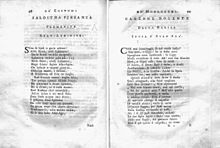Hasanaginica
| Hasanaginica Asanaginica |
|
|---|---|

The Mourning Song of the Noble Wife of the Asan Aga, the first publication of the ballad was in 1774 by Alberto Fortis in his work Viaggo in Dalmazia.
|
|
| Created | 1646–49 |
| Location | Imotski, Bosnia Eyalet, Ottoman Empire |
| Author(s) | South Slavic folk ballad |
| Purpose | Mourning song |
Hasanaginica, less commonly Asanaginica, (first published as "The Mourning Song of the Noble Wife of the Hasan Aga'") is a South Slavic folk ballad, created during the period of 1646–49, in the region of Imotski (in modern Croatia), which at the time was a part of the Bosnia Eyalet of the Ottoman Empire.
The ballad was handed down from generation to generation in oral form until it was finally written and published in 1774 by an Italian traveler and ethnographer Alberto Fortis in his book Viaggio in Dalmazia ('A travel across Dalmatia') while traveling through Dalmatia in 1770. During his travels, he discovered what he called a "Morlachian ballad" (a term he used to distinguish the peoples from coastal Dalmatia) from the inland locals, a term that was criticised by Croatian writer Ivan Lovrić, who accused Fortis of many factual errors in his own response, Notes on 'Travels in Dalmatia' of Abbe Alberto Fortis, which he then attempted to rectify. It was subsequently translated to German (Goethe, 1775), English (Scott, 1798), Russian (Pushkin 1835, beginning, and Akhmatova 1950s, in full), French (Mérimée, 1827 and Mickiewicz, 1841) and other world's languages, becoming an integral part of the world literary heritage already in the 18th century. Today, Asanaginica has been translated into more than 40 languages. It is considered a part of the Bosnian, Croatian and Serbian literary heritage.
...
Wikipedia
